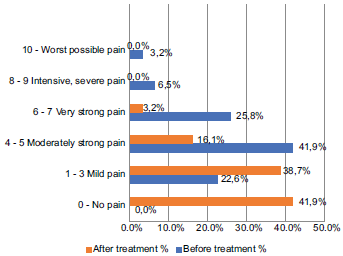The pain ratio before and after the application of physiotherapy for dysfunction of temporomandibular joint
DOI:
https://doi.org/10.17532/jhsci.2024.2752Keywords:
Temporomandibular joint dysfunction, physiotherapy, quality of life, pain management, pain measurementAbstract
Introduction: Physiotherapy, a non-invasive method of conservative treatment, that includes manual therapy, exercises and physical procedures, is used in the treatment of temporomandibular dysfunction and polyarticular laxity. It has been proven that physiotherapy focused on temporomandibular dysfunction is an essential element of treatment that leads to a reduction in pain, an improvement in temporomandibular joint (TMJ) function, and an improvement in quality of life. Physiotherapy treatment aims to alleviate the symptoms and try to restore the normal function of the masticatory system, for which various techniques can be used. The aim of the study was to determine the type, intensity, and frequency of TMJ dysfunction pain before and after physiotherapy.
Methods: The study was conducted in a private practice in Munich, Germany. All subjects who met the criteria for inclusion in the study completed a standardized questionnaire on TMJ dysfunction (TMJ disorder [TMJ/TMD] Questionnaire). The questionnaire was used to obtain data on the type and location of pain, duration of pain, and other symptoms related to the TMJ. The anamnestic data of the respondents who came to the doctor’s office with the symptoms mentioned were examined, and the orthodontic or dental findings were analyzed.
Results: The analysis showed that before treatment some of the joints were affected in 28 subjects, while after treatment the joints were affected in 19 subjects. After treatment a significant decrease in affected TMJ was observed (χ2 = 9.516, p = 0.008). Ear pain occurred in 17 (54.84%) subjects before treatment, and in 5 (16.13%) after treatment. A significant reduction was observed at the p = 0.003 level. Pain around the eyes occurred in 9 (29.03%) of the respondents before treatment, and after treatment in 2 (6.45%) of the respondents. Facial pain was reported in 16.13% of the anamnestic data before the treatment, and it was not reported in any of the respondents after treatment. There was also a significant reduction in the occurrence of tinnitus (p = 0.004). The occurrence of headaches also decreased after treatment (p < 0.001). Ear pressure was present before treatment in 45.16% of cases, and after treatment in 22.58% of cases, so there was no significant decrease.
Conclusion: Physiotherapy for people with TMJ dysfunction contributed significantly in reducing pain and alleviating other TMD symptoms.
Downloads

Downloads
Published
License
Copyright (c) 2024 Lejla Hadžić, Peter Heidemann, Samir Bojičić, Namik Trtak, Eldad Kaljić, Amra Mačak Hadžiomerović

This work is licensed under a Creative Commons Attribution 4.0 International License.










